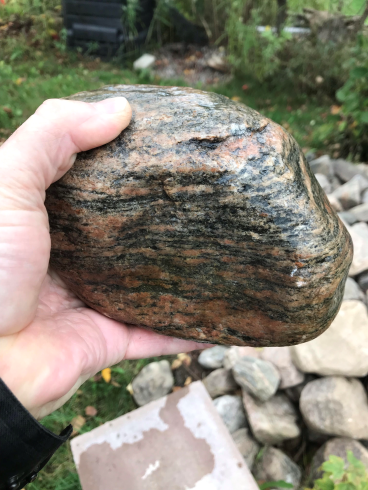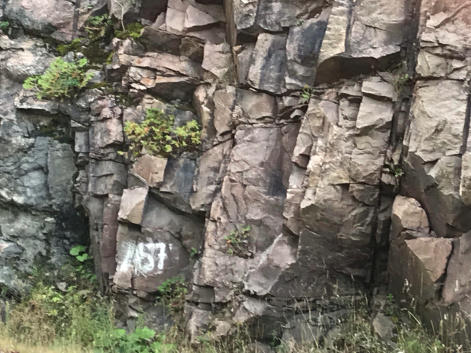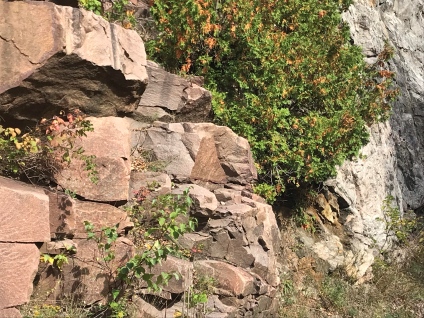As the terraces came into shape, I learned more about the stone I was working with.
“Your geology in Minden and Haliburton is quite different than ours,” explained Nadine’s cousin Jay, who lives with his family in Kingston, Ontario:
“Your stones are well-rounded because they were tumbled in the glacier melt, thousands of years ago. They were left to be found in the sand-glacial till mix.”

Stone farmers
Farmers here know this, as they have been plowing up rocks with rounded edges of all shapes and sizes, and leaving them in rough fencerows, for more than a hundred and fifty years in the Minden area. In fact, I had pilfered quite a few of these beauties from an old farm field boundary behind Nadine’s parents’ cottage on Horseshoe Lake years ago.
As the stones often have a rounded look to them, sometimes they are referred to as “river rock.” Fortunately, many of these tumbled stones do lend themselves to dry stone walling, as they may have at least one set of parallel edges.
Different parts of the country each tell their own stone stories. In contrast to the Minden/Haliburton area, the stone near Jay’s home in Kingston “is still being calved by the freeze/thaw cycle from the original rock,” he noted.
Metamorphosis
My friend Rob had seen the big pile of stone on our front lawn, delivered that spring by local aggregates supplier Brent Coltman. Rob had a closer look and identified the stone as mostly Gneiss (pronounced “nice”).
It’s a metamorphic rock — meaning it has been transformed under high pressure and temperatures. And it was rolled along on journeys propelled by the glaciers that once covered Ontario.
Not only is Gneiss nicely-rounded, but it has a banded, layered texture and splits fairly well. In a few cases where I needed to remove imperfections from a stone, I was able to find the seam of the stone and split off the bad bits with a hammer and stone chisel, and some patience. With a little more skill and practice, I could split more stone where needed to get flat edges.
“You can actually split it like firewood,” said Brent, who had dropped five tons of stone next to our cottage earlier that spring.
So the new terrace walls rising around the log cabin at our cottage were mostly made of Gneiss. And the thicker, heavier capstones I had obtained to top off the walls were from granite seams of rock that had been untouched by glaciers.
An ancient fault-line
Feeding my addiction to dry stone walling, my mother-in-law Ann gave me a book telling the fascinating backstory of stone in Ontario.
I learned about a giant fault line that bisects the tiny town of Miner’s Bay, just a short drive south of our cottage on Highway 35.

Nick Eyles, author of Road Rocks Ontario, describes the clash of two major divisions of the Canadian Shield, seen in the road cut on the highway there. One is the Central Gneiss Belt. The second is the Central Medisedimentary Belt. The contact between these two belts comprises rocks “that were stretched like warm toffee at temperatures up to 800C at a depth of up to 25 kilometres,” Eyles noted. Some Canadian Shield stone in Ontario is more than a billion years old.
The site at Miner’s Bay, which houses a popular old-style lodge between two lakes, “shows a superb outcrop of highly deformed marble.” This is made up of Gneiss and Granite — some of it marbleized and some busted up from tectonic activity. The tiny town also has a pretty church, its walls showcasing the beauty and diversity of local stone.

Eyles hypothesizes about earthquake potential in this area: “It’s an inexact science but (this fault line) may be capable of creating a magnitude 7 earthquake every couple of thousand years. The trouble is we don’t know when the last one was.”
Batten down the hatches!
Learning more about the stone from friends, family, and experts, made me appreciate the material I had been working with that summer to build terraces — its history, composition, and the beauty of its pink and grey layers.
So Gneiss!!

